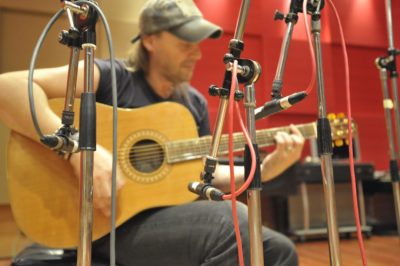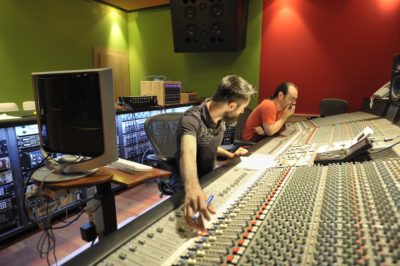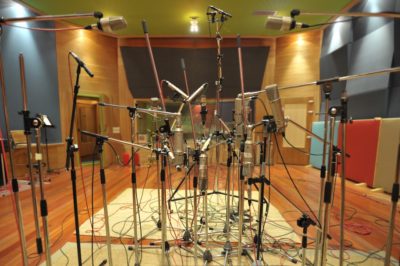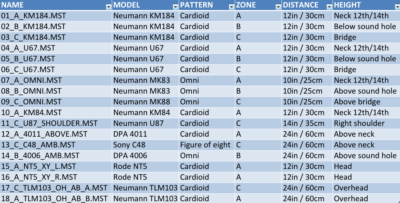Multi-Mic and Stereo Mic Techniques for Recording Acoustic Guitar

Guitarist David Palau in from of the three primary mic positions from last week: From left to right, Position “C” near the bridge, Position “B” slightly off-axis from the soundhole, and Position “A”, pointing to where the neck meets the body.
Last week, we explored a variety of ways to get an excellent acoustic guitar recording using a single microphone. The next logical step in the quest for different sonic nuances is to combine two or more microphones to obtain different colors.
While the single-mic techniques we demonstrated can be perfect for when the acoustic guitar needs to fit into a larger mix, for more sparse arrangements in which the guitar can spread out and take up some room, multi-mic approaches can give even more detail and sense of space.
A well-known marriage is to combine a KM84 pointing toward Position “A”, where the fingerboard meets the body (example #10 from last week) blended with a U87 at the over-the-shoulder position (example #11 from last week):
Similarly, you could combine any of two the close mics (examples #01 to #11) with a little bit of one of the more ambient mics (#13 or #14) for a richer and more spacious tone in mono.
As one example, this is the sound of a combination of mic #04—a Neumann U83 in the “A” position near the neck/body joint—with mic #13—A more distant Sony C48 pointing toward position “C”, with the second mic blended in 10db lower than the first one:
In this particular case, we’re just adding a very subtle amount of depth, as these ambient microphone positions were meant to sound good on their own, and so weren’t placed too far away and don’t contain a lot of room. The subtle effect you’ll hear in this example can be pronounced quite easily by backing the mic up further until it acts more and more liked a dedicated a “room” mic.
A variation on this idea takes advantage of mic position #12 from last week. This position features a sensitive small diaphragm condenser mic and hoisted up above the player, pointing down toward the fingerboard, and is very popular for recording flamenco guitar.
As mentioned earlier, it is usually combined with another mic at B or C position. This overhead mic provides all the “air” and details from the neck (it is usually hi-passed to provide just mids and highs) and is combined with a darker mic that provides the tone from the body of the instrument. Here is a combination of #11 and #12 (hi-passed):
Many of the mic positions we explored last time can be combined in a similar way. If you haven’t done so yet, try downloading the audio files from our mic techniques roundup on your favorite DAW and try combining mics in different positions.

Roger Montejano (L) and Caco Refojo (R) in front of PKO Studios’ SSL 9000J, auditioning acoustic guitar mic placements.
You might try, for example, combining position “A” near the neck which provides detail and clarity with, with position “C” near the bridge for more body and warmth.
When experimenting with these, consider that with so many mics available, it was very difficult to make sure all possible combinations would add constructively, so try flipping the polarity every now and then to make sure the phase relationships work.
Some stereo options
So far, we’ve looked at mono muli-mic techniques, but many of the possible combinations here can be used to obtain a satisfying stereo version of the instrument as well.
Combinations of positions A and C tend to work well here. Because they capture very different parts of the instrument, they are not usually hard-panned, but are instead panned just halfway.
For example pairing the U87 in position “C” (#10) with the KM84 in position “A” (#11) opens up the stereo image nicely when panned about 50% L and R. You may need to make a little adjustment to one of the two faders to ensure the image does not lean to one side:
You could also go a little wilder and use, for example, mics #01 (KM 184 in position “A”) and #06 (U67 in position “C”) as a hard-panned spaced pair to get a much wider sound.
Maybe not appropriate for all situations, but you can create very cool effects with this kind of wide image and some MS equalization.
Of course, any of the regular stereo mic techniques (ORTF, XY, NOS, Blumlein, Spaced Pair, etc.) can be used at any of the positions seen so far.
Due to lack of actual physical space to place any more mics for this roundup we couldn’t included all of these patterns but we did have enough space to try a couple of the most popular variations.
The first of these is an XY pair positioned between A and B, approximately aligned with the head of the guitarist, aiming above the sound hole. For this technique, a pair of Rode NT5 was used, as this is known to be a favorite choice of the legendary audio engineer Bruce Swedien:
As expected, the pair offers a nice stereo image, although not very wide due to the XY stereo technique used. Similar to the shoulder-position microphone, keeping the mics outside of the guitar’s main plane of projection imparts a somewhat ‘relaxed’ sound, though with a little more presence compared to the “over the shoulder” position.
It’s worth noting that an XY mic array can also be positioned in a vertical as well as a horizontal position. In a horizontal position, a bit more of the body of the guitar is apparent toward the left, while a bit more of the “air” and neck sound is heard toward the right.
Trying a vertical position shifts the stereo image slightly: Now, the bass strings shift slightly to one side, and the treble strings shift slightly to the opposite side, giving an impression a little bit like a stereo piano, but with an more even tonal balance on either side.
For more stereo spread, you can substitute an ORTF position for XY. For more roominess and space and a very natural sound, try an Blumlein technique, in which the XY stereo pair is put into bi-directional mode.
Using overhead mics is probably not the first thing you might think about when recording acoustic guitar, but they can prove very useful. Mics #17 and #18 are two Neumann TLM103 as an AB spaced pair right above the guitar player. Here is how they sound:
This has become a personal favorite, especially when combined with a mic at position “B” to anchor a little the center image. This is how the combination of mics #17 and #18 plus #02 sounds:
In this example, the three mics were summed at the same level for a bit of an exaggerated stereo image, but you can add a very nice and subtle 3D-stereo effect to any mono mic by folding in these stereo overhead mics at a lower level.
Summing it Up
I hope this roundup has helped you grab some cool ideas and developed a better intuition for the next time you’re swapping mics around an acoustic guitar to get coax out all its nuances.
There are, of course, as many possible approaches as there are audio engineers, and if you have any cool tricks of your own, please share them in the comments.
Special thanks to PKO, Caco Refojo, Gemma Lapeña, David Palau and Jose Antonio Pajares for their commitment in the creation of this story.
Please note: When you buy products through links on this page, we may earn an affiliate commission.








